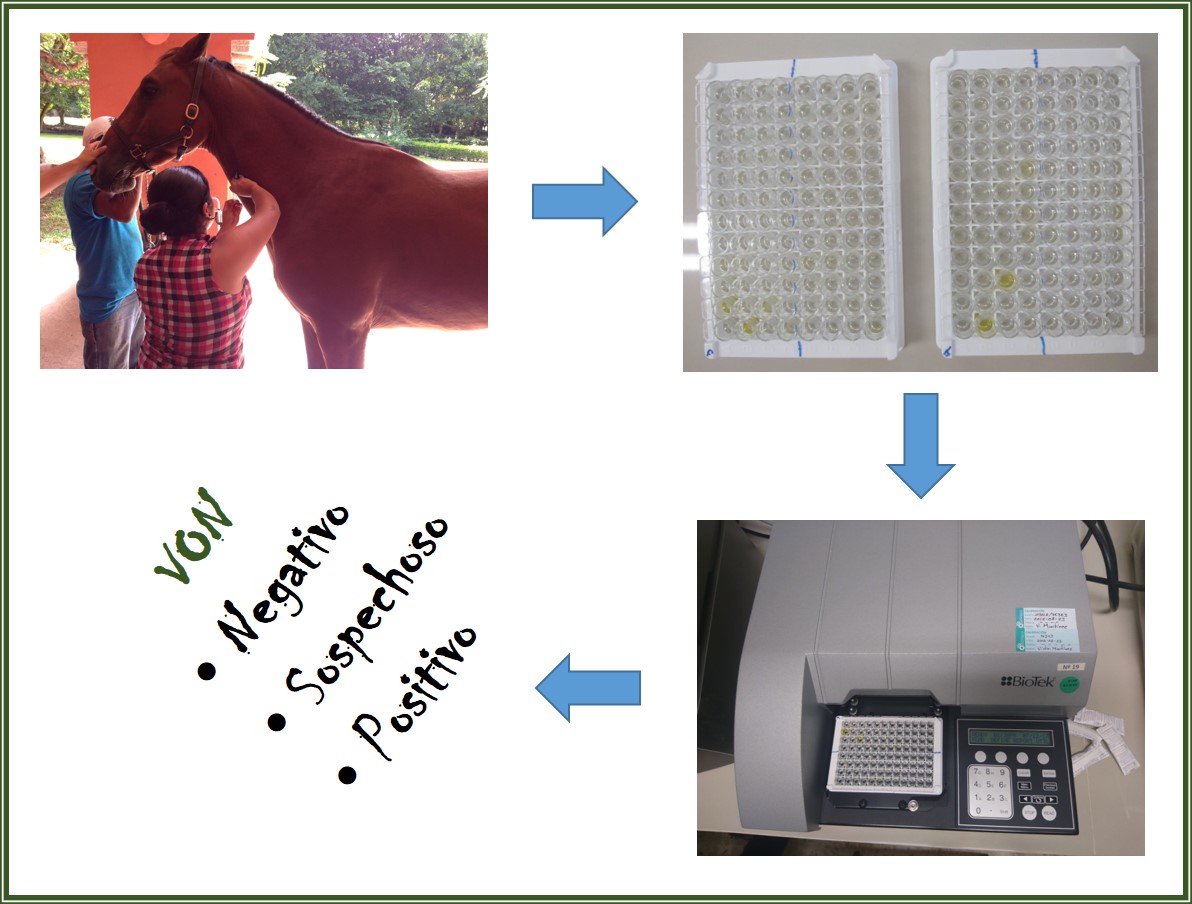Recent infection of West Nile Virus in horses from eastern Yucatán, Mexico
Infección reciente del virus del Oeste del Nilo en caballos del oriente de Yucatán, México

Show authors biography
Objective. To determine the circulation of West Nile virus (WNV) in horses from the eastern Yucatán, Mexico. Materials and Methods. For convenience, 184 horses from 23 production units in the municipalities of Tizimín and Panabá, Yucatán, were studied. A blood serum sample was obtained from each studied horse and evaluated with an immunoglobulin M antibody-capture enzyme-linked immunosorbent assay (MAC-ELISA) to detect immunoglobulin M (IgM) against WNV. Additionally, positive reactor and suspect serum samples were analyzed by reverse transcription polymerase chain reaction (RT-PCR) to detect viral RNA. Results. Eight studied horses were seropositive (4.3%, 8/184) to WNV and two were suspects (1.1%, 2/184). All serum samples were negative by RT-PCR. Conclusions. The detection of IgM specific against WNV in the studied horses shows recent infections with the virus and indicates its circulation in eastern Yucatán, Mexico.
Article visits 1215 | PDF visits
Downloads
- Chancey C, Grinev A, Volkova E, Rios M. The global ecology and epidemiology of West Nile Virus. BioMed Res Int. 2015; Article ID: 376230. http://dx.doi.org/10.1155/2015/376230
- David S, Abraham AM. Epidemiological and clinical aspects on West Nile Virus, a globally emerging pathogen. Infect Dis. 2016; 48(8):571-586. http://dx.doi.org/10.3109/23744235.2016.1164890
- Al-Jabi SW. Global research trends in West Nile virus from 1943 to 2016: a bibliometric analysis. Global Health. 2017; 13:55. http://dx.doi.org/10.1186/s12992-017-0284-y
- Loza-Rubio E, Rojas-Anaya E, López-Ramírez R, Saiz J, Escribano-Romero E. Prevalence of neutralizing antibodies against West Nile Virus (WNV) in monkeys (Ateles geoffroyi and Alouatta pigra) and crocodiles (Crocodylus acutus and C. acutus-C. moreletti hybrids) in Mexico. Epidemiol Infect. 2016; 144(11):2371-2373. http://dx.doi.org/10.1017/S0950268816000790
- Pérez-Ruiz M, Sanbonmatsu GS, Claverob JMA. Infección por virus West Nile. Enferm Infecc Microbiol Clin. 2011; 29(Supl.5):21-26. http://dx.doi.org/10.1016/S0213-005X(11)70040-4
- García-Ruíz D, Martínez-Guzmán MA, Cárdenas-Vargas A, Marino-Marmolejo E, Gutiérrez-Ortega A, González-Diaz E, et al. Detection of dengue, west Nile virus, rickettsiosis and leptospirosis by a new real-time PCR strategy. Springerplus. 2016; 5(1):671. http://dx.doi.org/10.1186/s40064-016-2318-y
- CDC: Centers for Disease Control and Prevention. West Nile Virus in the United States: Guidelines for surveillance, prevention, and control [Internet]. Fort Collins, Colorado, US. 2013. URL disponible en: http://www.cdc.gov/westnile/resources/pdfs/wnvguidelines.pdf
- Garcia-Bocanegra I, Arenas-Montes A, Jaen-Tellez A, Napp S, Fernandez-Morente M, Arenas A. Use of sentinel serosurveillance of mules and donkeys in the monitoring of West Nile virus infection. Vet J. 2012; 194(2):262-264. http://dx.doi.org/10.1016/j.tvjl.2012.04.017
- Barbachano-Guerrero A, Vásquez-Aguilar AA, Aguirre A, Zavala-Norzagaray AA, Carrera-Gonzalez E, Lafón-Terrazas A, et al. West Nile virus prevalence in wild birds from Mexico. J Wild Dis. 2019; 55(2):425-431. http://dx.doi.org/10.7589/2018-03-065
- Loroño-Pino M, Blitvich B, Farfán-Ale J, Puerto F, Blanco J, Marlenee N, et al. Serologic evidence of West Nile Virus infection in horses, Yucatan State, Mexico. Emerg Infect Dis. 2003; 9(7):857–859. http://dx.doi.org/10.3201/eid0907.030167
- Loroño-Pino MA, Farfan-Ale JA, Garcia-Rejon JE, Lin M, Rosado-Paredes E, Puerto FI, et al. Antibodies to influenza and West Nile viruses in horses in Mexico. Vet Rec. 2010; 166(1):22–23. http://dx.doi.org/10.1136/vr.b5586
- Chaves A, Sotomayor-Bonilla J, Monge O, Ramírez A, Galindo F, Sarmiento-Silva E, et al. West Nile virus in resident birds from Yucatan, Mexico. J Wild Dis. 2016; 52(1):159–163. http://dx.doi.org/10.7589/2015-02-046
- INEGI: Instituto Nacional de Estadística, Geografía e Informática. Anuario estadístico y geográfico de Yucatán. Mérida, Yucatán. 2017. URL disponible en: http://www.datatur.sectur.gob.mx/ITxEF_Docs/YUC_ANUARIO_PDF16.pdf
- Joó K, Bakonyi T, Szenci O, Sárdi S, Ferenczie E, Barna M, et al. Comparison of assays for the detection of West Nile virus antibodies in equine serum after natural infection or vaccination. Vet Immunol Immunopathol. 2017; 183:1-6. http://dx.doi.org/10.1016/j.vetimm.2016.10.015
- Long MT, Jeter W, Hernandez J, Sellon DC, Gosche D, Gillis K, et al. Diagnostic performance of the equine IgM capture ELISA for serodiagnosis of West Nile virus infection. J Vet Intern Med. 2006; 20(3):608–613. http://dx.doi.org/10.1892/0891-6640(2006)20[608:dpotei]2.0.co;2
- Lanciotti RS, Kerst AJ, Nasci S, Godsey S, Mitchell J, Savage M, et al. Rapid detection of West Nile virus from human clinical specimens, field-collected mosquitoes, and avian samples by a TaqMan Reverse Transcriptase-PCR Assay. J Clin Microbiol. 2000; 38(11):4066–4071. https://www.ncbi.nlm.nih.gov/pmc/articles/PMC87542/
- Mattar S, Edwards E, Laguado J, González M, Álvarez J, Komar N. West Nile virus antibodies in Colombian horses. Emerg Infect Dis. 2005; 11(9):1497–1498. http://dx.doi.org/10.3201/eid1109.050426
- De Filette M, Ulbert S, Diamond S, Sanders N. Recent progress in West Nile virus diagnosis and vaccination. Vet Res. 2012; 43:16. https://doi.org/10.1186/1297-9716-43-16
- OIE: Organización Mundial de Sanidad Animal. Manual de las pruebas de diagnóstico y de las vacunas para los animales terrestres, Fiebre del Nilo Occidental. París, Francia. 2018. URL disponible en: https://www.oie.int/es/normas/manual-terrestre/acceso-en-linea/
- Barbić L, Stevanović V, Kovač S, Maltar L, Lohman JI, Vilibić-Cavlek T, et al. West Nile virus serosurveillance in horses in Croatia during the 2012 transmission season. RAD 517. Medical Sciences. 2013; 39:95-104. http://www.id-vet.com/pdfs/pdfs/WNIGM/doc261.pdf
- EPA: US Environmental Protection Agency. 2016. Climate Change Indicators: West Nile Virus. United States [Internet]. URL disponible en https://www.epa.gov/climate-indicators/climate-change-indicators-west-nile-virus
- Colpitts TM, Conway MJ, Montgomery RR, Fikrig E. West Nile virus: Biology, transmission, and human infection. Clin Microbiol Rev. 2012; 25(4):635–648. http://dx.doi:10.1128/CMR.00045-12
- Dzul-Manzanilla F, Manrique-Saide P, Che-Mendoza A, Rebollar-Téllez E. Mosquitos de Yucatán. Biodiversidad y desarrollo humano en Yucatán, regionalización socio-productiva y biodiversidad. CICY, PPD-FMAM, CONABIO, SEDUMA: Mérida, Yucatán, México; 2010.
- Kilpatrick A. Globalization, land use and the invasion of West Nile virus. Science. 2011; 334(6054):323–327. http://dx.doi:10.1126/science.1201010
- Brault A, Langevin SA, Ramey WN, Fang Y, Beasley DWC, Barker CM, et al. Reduced avian virulence and viremia of West Nile virus isolates from Mexico and Texas. Am J Trop Med Hyg. 2011; 85(4):758–767. http://dx.doi:10.4269/ajtmh.2011.10-0439
- Langevin A, Bowen RA., Ramey WN, Sanders TA, Maharaj PD., Fang Y, et al. Envelope and pre-membrane protein structural amino acid mutations mediate diminished avian growth and virulence of a Mexican West Nile virus isolate. J Gen Virol. 2011; 92:2810–2820. https://doi.org/10.1099/vir.0.035535-0
- Jaramillo M, Peña J, Berrocal L, Komar N, González M, Ariza K, et al. Vigilancia centinela para el virus del oeste del Nilo en culícidos y aves domésticas en el departamento de Córdoba. Rev MVZ-Córdoba. 2005; 10(2):633-638. https://doi.org/10.21897/rmvz.467























